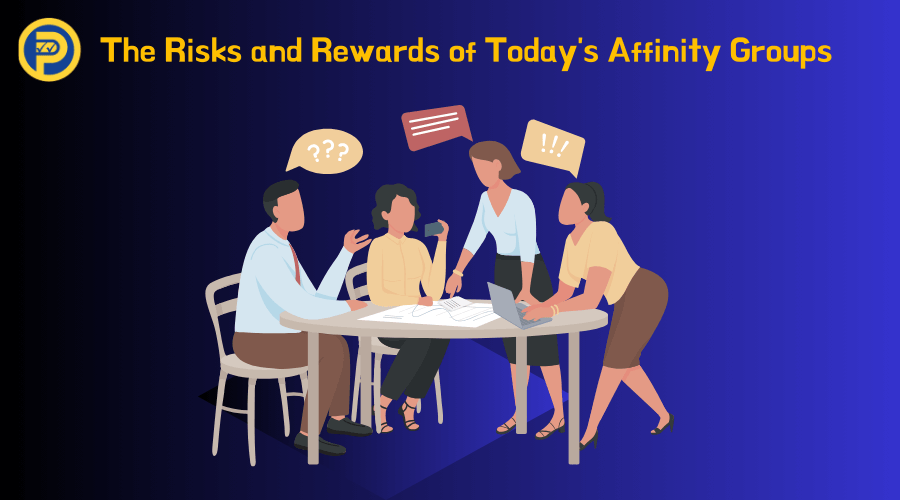Affinity groups, also known as employee resource groups (ERGs), have become pivotal in shaping workplace culture and enhancing employee experiences.
These groups are formed around shared identities or interests, providing a platform for employees to connect, support one another, and advocate for change.
As organizations increasingly prioritize diversity, equity, and inclusion (DEI), affinity groups serve as a vital tool for fostering a sense of belonging and community. However, while they offer numerous benefits, they also come with risks that organizations must navigate carefully.
This article delves into the various types of affinity groups, their impact on company culture, the associated risks and rewards, and successful examples from large corporations, all while aligning with best practices in human resource management.
Learn: How Does Paying Minimum Wage Affect the Economy
Types of Affinity Groups in the Workplace
Affinity groups can take many forms, each serving a unique purpose within the workplace. Here are some common types:
- Cultural or Identity-Based Groups: These groups often focus on shared racial, ethnic, or cultural backgrounds, such as Black Employee Networks or Asian Pacific Islander groups. They provide a platform for members to celebrate their heritage and address challenges unique to their communities.
- Gender and Sexual Orientation Groups: Groups such as Women in Leadership networks aim to support and empower individuals based on gender and sexual identity. They often focus on mentorship, professional development, and advocacy for equitable workplace practices.
- Interest-Based Groups: These groups unite employees around shared interests, such as environmental sustainability, volunteering, or wellness. They promote engagement and collaboration among employees who share common passions.
- Generational or Life Stage Groups: Groups that focus on specific life stages, such as parents or veterans, provide support and resources tailored to the unique challenges faced by these individuals.
- Religious Affinity Groups: These groups cater to employees who share specific religious beliefs or practices. By providing a space for individuals to discuss their faith, celebrate religious holidays, and address unique challenges, such as work-life balance during religious observances, these groups foster a sense of belonging and understanding among employees of similar faiths.
Kickstart you SHRM exam preparation by accessing practice questions from our SHRM-CP Test Prep and SHRM-SCP Test Prep programs
How Can Affinity Groups Impact Company Culture?
Affinity groups can significantly influence company culture by fostering an environment of inclusion and collaboration.
They create safe spaces where employees feel comfortable sharing their experiences and perspectives, which can lead to greater empathy and understanding across diverse teams.
By encouraging open dialogue, affinity groups help break down silos and promote a culture of transparency and trust.
Moreover, these groups can drive cultural change by advocating for policies and practices that support diversity and inclusion.
When employees feel valued and heard, they are more likely to be engaged and committed to their work. This heightened engagement can lead to increased productivity and morale, ultimately benefiting the organization as a whole.
Additionally, affinity groups can enhance recruitment efforts by showcasing the organization’s commitment to diversity.
Potential candidates are increasingly looking for workplaces that prioritize inclusion, and active affinity groups can serve as a testament to an organization’s values. This alignment can attract a more diverse talent pool, further enriching the company culture.
Check out: 10 Reasons as to Why Companies Post Jobs if they Hire Internally
The Risks of Affinity Groups
While affinity groups can offer numerous benefits, they also present several risks that organizations must navigate carefully:
Potential for Exclusion
One of the primary concerns surrounding affinity groups is the potential for exclusion. Employees who do not identify with the group’s focus may feel alienated or marginalized, leading to feelings of resentment or division within the workplace.
This can be particularly problematic if the affinity group is perceived as an exclusive club rather than an inclusive community.
Legal and Compliance Issues
Affinity groups can inadvertently raise legal concerns, particularly regarding discrimination and harassment. If not managed properly, these groups may create an environment where certain employees feel threatened or discriminated against.
Employers must ensure that all employees feel welcome to participate in group activities and that discussions remain respectful and inclusive.
Misuse of Social Media
The use of social media and communication platforms for affinity group discussions can lead to misunderstandings or inappropriate conduct.
Employers must establish clear guidelines for online interactions to avoid potential conflicts and ensure compliance with labor laws, such as the National Labor Relations Act, which protects employees’ rights to engage in concerted activities.
The Rewards of Affinity Groups
Despite the risks, the rewards of affinity groups can significantly enhance workplace culture and employee satisfaction:
Enhanced Employee Engagement and Retention
Affinity groups foster a sense of belonging and community among employees, which can lead to increased engagement and retention. Research indicates that organizations with strong diversity and inclusion practices experience lower turnover rates and higher employee morale.
By providing a platform for employees to connect and share their experiences, affinity groups can help create a more cohesive and supportive workplace environment.
Find out: Can You Collect Unemployment Benefits If Fired Due to Attendance Issues
Leadership Development Opportunities
Affinity groups often serve as a breeding ground for leadership development. Members can take on leadership roles within the group, gaining valuable experience that can translate into career advancement.
This is especially beneficial for underrepresented employees who may lack access to traditional mentorship opportunities.
Innovation and Collaboration
Diverse teams are known to drive innovation and creativity. Affinity groups bring together individuals with varied perspectives, fostering collaboration and idea-sharing that can lead to innovative solutions and improved business outcomes.
Companies that embrace diversity are often better positioned to understand and meet the needs of a diverse customer base.

Successful Examples of Affinity Groups in Large Corporations
Many large corporations have successfully implemented affinity groups, demonstrating their effectiveness in promoting diversity and inclusion:
- Amazon: The Black Employee Network (BEN) at Amazon has been instrumental in advocating for the needs of Black employees. It has led to initiatives such as the creation of a Black haircare store, Textures & Hues, which was born out of group discussions. This initiative not only provided a new business avenue but also showcased Amazon’s commitment to understanding and serving diverse customer needs.
- Google: Google has established various affinity groups, including the Women’s Network and Employee Resource Group. These groups focus on mentorship, professional development, and advocacy for policies that support diversity. The company actively involves these groups in decision-making processes, ensuring that diverse perspectives are considered in corporate strategies.
- Microsoft: Microsoft’s affinity groups, such as the Black Employee Network and the Disability Employee Resource Group, have played a crucial role in shaping the company’s DEI initiatives. These groups provide employees with a platform to voice their concerns and collaborate on solutions, fostering a culture of inclusion and respect.
Try out: SHRM-SCP Free Questions
Aligning Affinity Groups with SHRM Best Practices
To maximize the benefits of affinity groups while mitigating risks, organizations should align their practices with SHRM’s principles of effective human resource management:
Establish Clear Objectives
Organizations should define the purpose and goals of each affinity group clearly. This includes outlining how the group will contribute to the company’s diversity and inclusion efforts, as well as establishing guidelines for participation and communication.
Foster Inclusivity
Employers must ensure that affinity groups are open to all employees, regardless of their background.
This encourages cross-group collaboration and helps prevent feelings of exclusion. Regularly soliciting feedback from all employees can help identify areas for improvement and ensure that the groups remain inclusive and relevant.
Provide Support and Resources
Organizations should offer support and resources to affinity groups, including training for leaders and access to organizational tools. This can help ensure that the groups operate effectively and align with the company’s overall mission and values.
Monitor and Evaluate
Regularly assessing the impact of affinity groups on employee engagement and workplace culture is essential. Employers should track participation rates, gather feedback, and evaluate the overall effectiveness of the groups in achieving their objectives.
This data can inform future initiatives and help refine the approach to affinity groups within the organization.
Read: How Do I Get SHRM Certified?
FAQS
What Makes an Affinity Group?
Affinity groups are formed by individuals who share common interests, goals, or identities, fostering a sense of belonging and community. These groups typically focus on promoting diversity, equity, and inclusion within organizations.
They provide a platform for members to voice concerns, share experiences, and support one another professionally and personally.
Effective affinity groups have a clear mission, defined leadership, and structured activities that align with organizational objectives.
They can also enhance cultural awareness and contribute to recruitment and retention efforts, ultimately benefiting both members and the organization as a whole
What are the Most Common Affinity Groups?
Affinity groups are typically organized around shared characteristics or interests, fostering community and support among members. The most common types include:
- Cultural and Ethnic Groups: These focus on shared heritage, such as Latino, Asian, or African American groups.
- Gender-Based Groups: Often centered around women or men, these groups address specific issues related to gender equality and representation.
- Interest-Based Groups: These can include groups focused on hobbies, professional interests, or social issues, such as environmental advocacy or technology.
What are Cultural Affinity Groups?
Cultural Affinity Groups are organized communities within organizations that unite individuals based on shared cultural backgrounds or identities.
These groups aim to foster inclusivity, support diversity, and enhance employee engagement by providing a platform for members to connect, share experiences, and advocate for cultural awareness.
They often focus on issues relevant to their specific cultural contexts, promoting understanding and collaboration among diverse employee populations.
Affinity groups can play a crucial role in shaping organizational policies and practices that reflect the values of diversity, equity, and inclusion, ultimately contributing to a more harmonious workplace environment.

